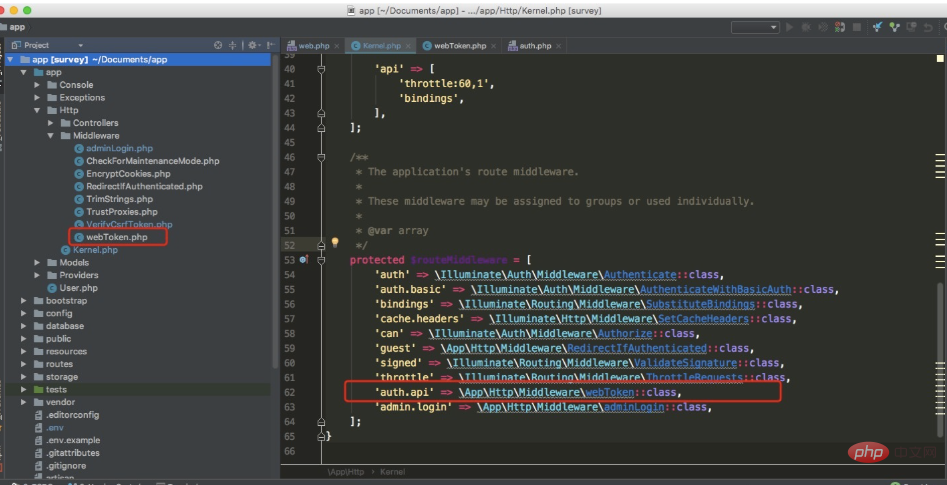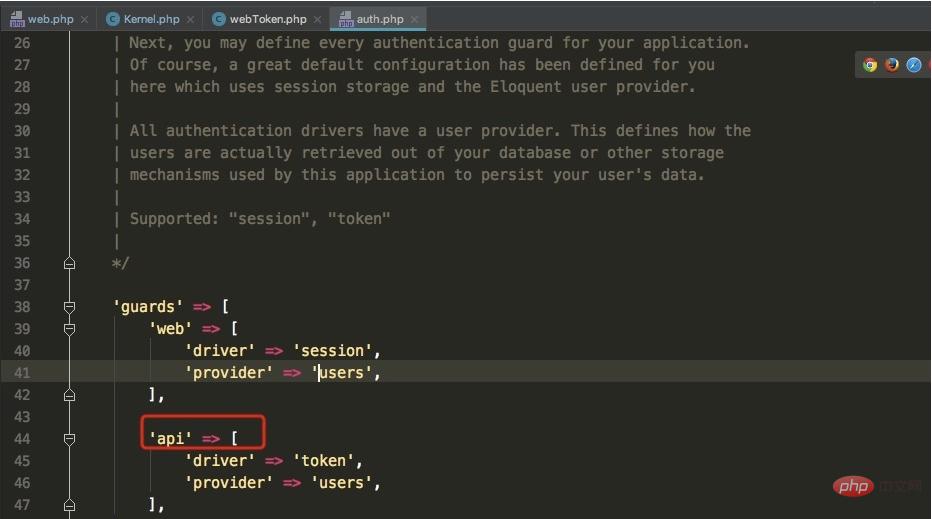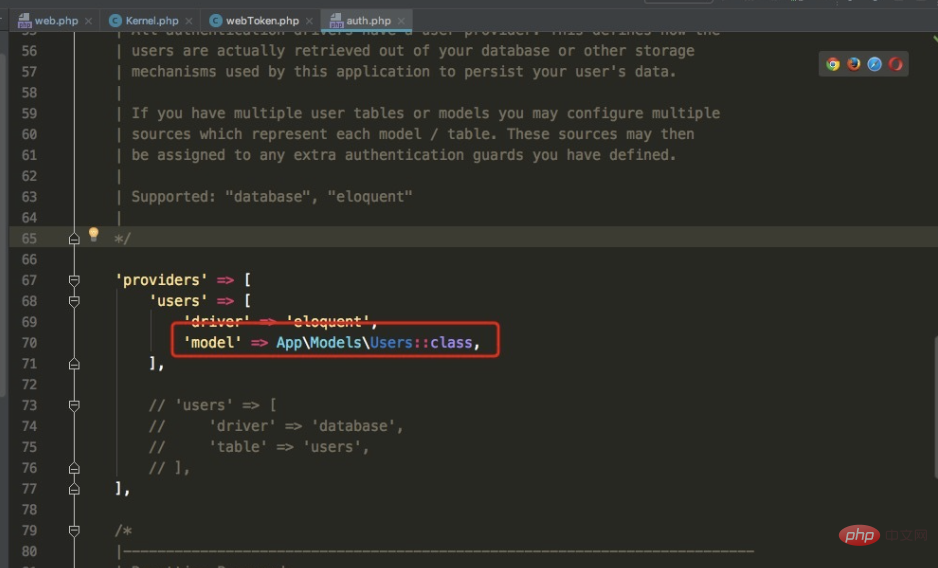How Laravel uses ApiToken to authenticate requests
The following tutorial column of Laravel Getting Started will introduce you to the method of using ApiToken authentication request in Laravel. I hope it will be helpful to friends in need!

1. Open the database/migrations/2014_10_12_000000_create_users_table.php migration file. We need to change the structure of the user table.
2. We need to add api_token field, that is to say, our token is saved in the database. In the appropriate location, add a row
$table->string('api_token', 60)->unique();
3. Configure the database and generate the user table through the php artisan migrate command
4. In the user table, add a record at will, as long as the api_token field is set to 123456. In this way, we generate a user, and we can use the token value 123456 to log in later.
5. Return to the routing file routes.php, add a test route in it, and protect it with laravel middleware
Route::group(['middleware' => ['auth.api']], function () {
Route::get('/t', function () {
return 'ok';
});
});Here, the auth.api middleware is used, and the middleware definition Enter the picture below:

Create WebToken.php in the Middleware file, and then register the middleware in the Kernel.php file
'auth.api' => \App\Http\Middleware\webToken::class,
6. Open the just created The webToken middleware code is as follows
<?php
namespace App\Http\Middleware;
use Closure;
use Illuminate\Support\Facades\Auth;
class webToken
{
/**
* Handle an incoming request.
*
* @param \Illuminate\Http\Request $request
* @param \Closure $next
* @return mixed
*/
public function handle($request, Closure $next)
{
if (Auth::guard('api')->guest()) {
return response()->json(['code' => 401,'msg' => '未设置token']);
}
return $next($request);
}
}The api of Auth::guard('api') in the code is the auth.php file in the config folder


7. After making the above modifications, when we directly initiate a request to the server with the URL path /t, the server will return a 401 error and a 'token not set' Such a message is what we set in the handle() method before. In other words, /t has been protected by our auth middleware. If we want our request to pass through this middleware normally, we must provide the token .
8. Since we previously added a piece of data with api_token 123456 in the user table, now we request /t from the server again, but this time we add api_token, which is
…/t?api_token=123456
Under normal circumstances, the server will return 'ok', which means that the auth middleware allows this request to pass. But when we change 123456 to other values, this request cannot pass the auth middleware.
For more laravel framework technical articles, please visit laraveltutorial!
The above is the detailed content of How Laravel uses ApiToken to authenticate requests. For more information, please follow other related articles on the PHP Chinese website!

Hot AI Tools

Undresser.AI Undress
AI-powered app for creating realistic nude photos

AI Clothes Remover
Online AI tool for removing clothes from photos.

Undress AI Tool
Undress images for free

Clothoff.io
AI clothes remover

Video Face Swap
Swap faces in any video effortlessly with our completely free AI face swap tool!

Hot Article

Hot Tools

Notepad++7.3.1
Easy-to-use and free code editor

SublimeText3 Chinese version
Chinese version, very easy to use

Zend Studio 13.0.1
Powerful PHP integrated development environment

Dreamweaver CS6
Visual web development tools

SublimeText3 Mac version
God-level code editing software (SublimeText3)

Hot Topics
 1386
1386
 52
52
 Laravel - Artisan Commands
Aug 27, 2024 am 10:51 AM
Laravel - Artisan Commands
Aug 27, 2024 am 10:51 AM
Laravel - Artisan Commands - Laravel 5.7 comes with new way of treating and testing new commands. It includes a new feature of testing artisan commands and the demonstration is mentioned below ?
 Laravel - Pagination Customizations
Aug 27, 2024 am 10:51 AM
Laravel - Pagination Customizations
Aug 27, 2024 am 10:51 AM
Laravel - Pagination Customizations - Laravel includes a feature of pagination which helps a user or a developer to include a pagination feature. Laravel paginator is integrated with the query builder and Eloquent ORM. The paginate method automatical
 How to get the return code when email sending fails in Laravel?
Apr 01, 2025 pm 02:45 PM
How to get the return code when email sending fails in Laravel?
Apr 01, 2025 pm 02:45 PM
Method for obtaining the return code when Laravel email sending fails. When using Laravel to develop applications, you often encounter situations where you need to send verification codes. And in reality...
 Laravel schedule task is not executed: What should I do if the task is not running after schedule: run command?
Mar 31, 2025 pm 11:24 PM
Laravel schedule task is not executed: What should I do if the task is not running after schedule: run command?
Mar 31, 2025 pm 11:24 PM
Laravel schedule task run unresponsive troubleshooting When using Laravel's schedule task scheduling, many developers will encounter this problem: schedule:run...
 In Laravel, how to deal with the situation where verification codes are failed to be sent by email?
Mar 31, 2025 pm 11:48 PM
In Laravel, how to deal with the situation where verification codes are failed to be sent by email?
Mar 31, 2025 pm 11:48 PM
The method of handling Laravel's email failure to send verification code is to use Laravel...
 How to implement the custom table function of clicking to add data in dcat admin?
Apr 01, 2025 am 07:09 AM
How to implement the custom table function of clicking to add data in dcat admin?
Apr 01, 2025 am 07:09 AM
How to implement the table function of custom click to add data in dcatadmin (laravel-admin) When using dcat...
 Laravel Redis connection sharing: Why does the select method affect other connections?
Apr 01, 2025 am 07:45 AM
Laravel Redis connection sharing: Why does the select method affect other connections?
Apr 01, 2025 am 07:45 AM
The impact of sharing of Redis connections in Laravel framework and select methods When using Laravel framework and Redis, developers may encounter a problem: through configuration...
 Laravel - Dump Server
Aug 27, 2024 am 10:51 AM
Laravel - Dump Server
Aug 27, 2024 am 10:51 AM
Laravel - Dump Server - Laravel dump server comes with the version of Laravel 5.7. The previous versions do not include any dump server. Dump server will be a development dependency in laravel/laravel composer file.




